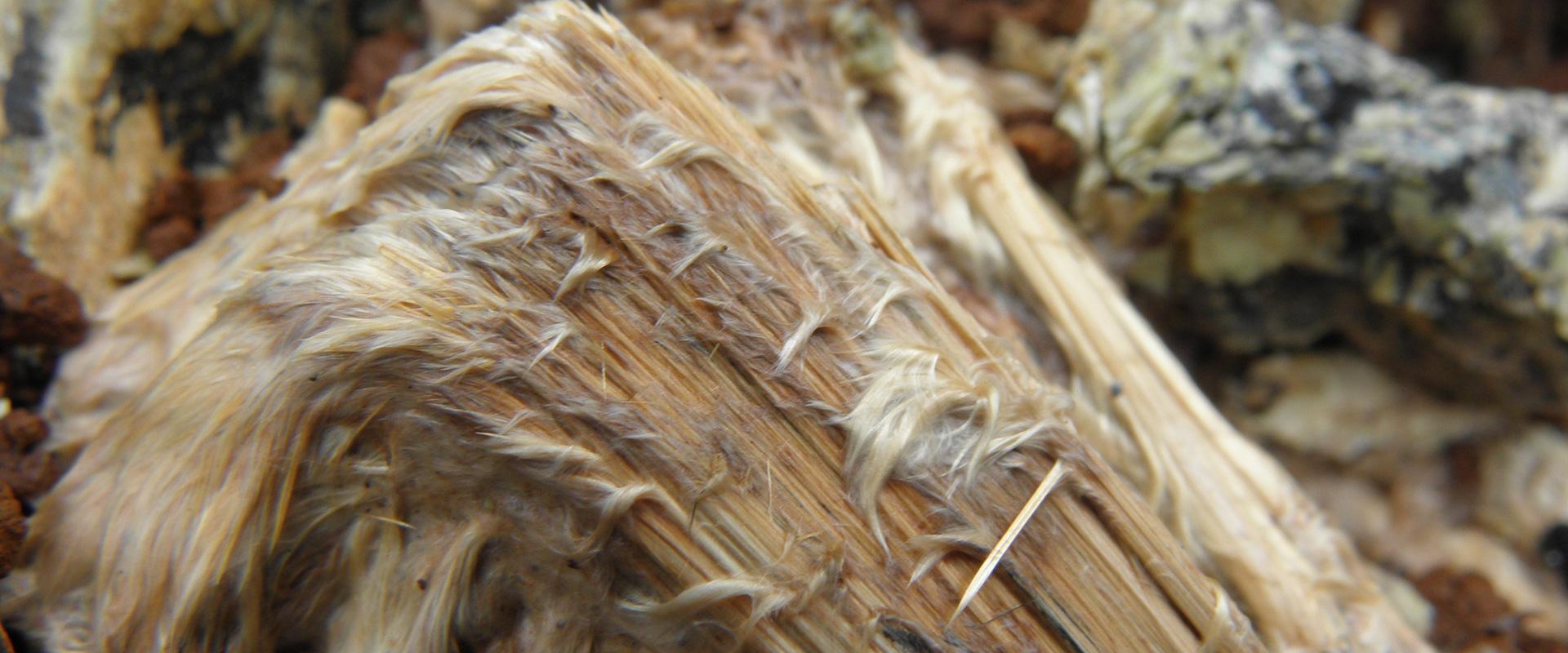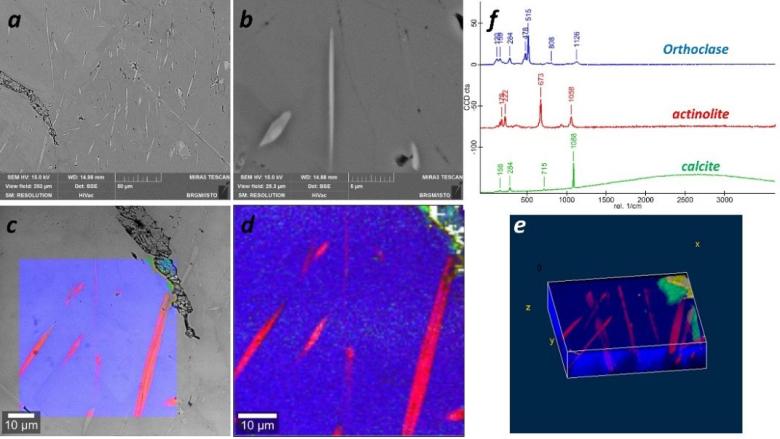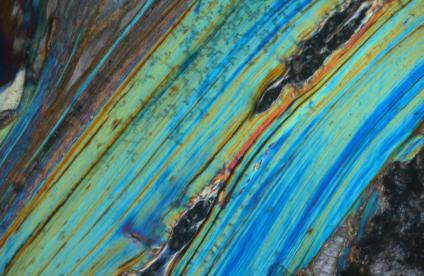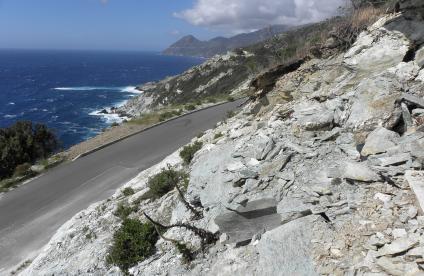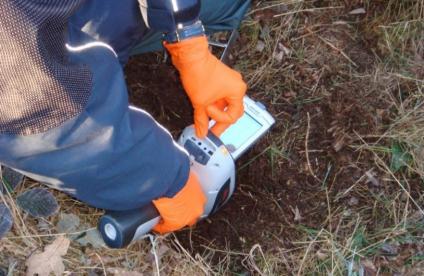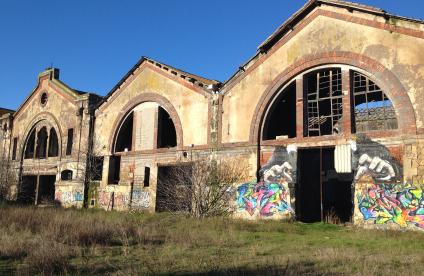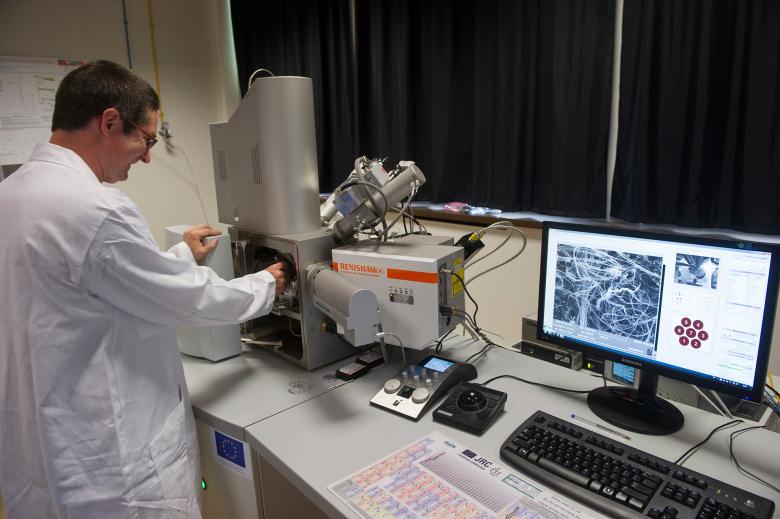
Analysis using a scanning electron microscope coupled with a Raman spectrometer (2012).
© BRGM - Didier Depoorter
Issues and needs
Companies frequently come into contact with asbestos when treating asbestos waste, or during drilling or quarrying operations.
The diagnosis of environmental asbestos in materials is governed by a number of standards, relating to the detection of asbestos before starting work (NF P 94-001) or the presence of asbestos in natural materials – rocks and aggregates – (NF ISO 22262-2, NF X-43.050). All of these standards are subject to strict analytical protocols.
Detecting asbestos is more complex in natural materials than in manufactured materials. It requires geological expertise of the field and advanced characterisation methods. The analytical procedure is made more difficult by the variability of these materials in terms of their petrographic (rock composition), mineralogical and textural characteristics, as well as by the need to differentiate asbestos fibres from elongate mineral particles that have the same chemical composition but are non-asbestiform.
In addition, sample preparation procedures, such as grinding, can seriously affect the quality of diagnostics. This is because these procedures can sometimes lead to the production of fibriform cleavage fragments that could be confused with asbestos fibres, particularly if the morphological identification criteria applied are not sufficiently precise or discriminating.
For this reason, we need to envisage the implementation of new protocols or innovative characterisation technologies in order to improve the reliability of diagnostic techniques, alongside the standard protocols currently in force. Appropriate analyses are therefore required in order to effectively protect workers and local residents and to ensure the smooth running of the work site with respect to the constraints arising from the presence of natural asbestos-bearing soils.
Our added value
Building on its experience in the characterisation of materials, whether natural, manufactured or synthetic, asbestos-containing or not, BRGM implements a wide range of methods for preparing and processing samples. Drawing upon their expertise, BRGM’s skilled engineers and analysts are able to address your problems in a wide range of areas:
Preliminary sample analysis:
- Solids preparation: sampling, crushing, multi-method grinding, sawing, polished sections and thin sections;
- Physical tests to assess the asbestos emission capacity of quarry materials (aggregate, sand, alluvium, etc.) by reproducing the effects of friction and wear;
- Physical-chemical analysis: Polarised Light Optical Microscopy (PLOM), Scanning Electron Microscopy (SEM-EDS).
Advanced characterisation and implementation of an in-situ protocol avoiding cleavage fragments:
- Crystallographic and isotopic analysis using multi-tool coupling: Raman Spectroscopy (SEM-Raman and 3D Raman), X-ray Diffraction (XRD), Infrared Spectroscopy (IRTF), Transmission Electron Microscopy (TEM), Focused Ion Beam Scanning Electron Microscopy (FIB-SEM), X-ray Fluorescence, (ICP-AES);
- 3D sample analysis: distribution / volume fraction / morphology of non-fibrous amphiboles;
- Non-destructive study of thin sections: polished sections conserving the structure of the sample for a robust result.
The development of specific new methods for identifying the presence of asbestos:
- Innovative on-site devices to detect asbestos in materials using an optical chamber;
- Hyperspectral imaging to detect asbestos in outcrops;
- Production of calibrated samples (composition and reference length) in BRGM laboratories.
These different methods are presented as part of asbestos training courses, tailored to your needs.
Technical resources
- InfoTerre: portal giving access to BRGM data relating to asbestos in particular
- Sample preparation and analysis laboratories (mineralogical, crystallographic, physico-chemical and textural)
- Patent: LODAIM – System for the on-site detection of asbestos particles in building materials (No. FR 21 00625 – patent pending)
References
- Pre-feasibility study concerning the extraction and identification of asbestos-bearing minerals in natural environments and quarries (PIMAC) - Report BRGM/RP-66008-FR
- Characterisation on construction sites in a range of fields: energy (Electricité de France), building and public works, etc.
- Testing a system to detect asbestos in materials (LOC-AMIANTE)
Scientific publications
- Lahondère et al., 2019. Naturally occurring asbestos in an alpine ophiolitic complex (northern Corsica, France). Environmental Earth Sciences. 78:540. https://doi.org/10.1007/s12665-019-8548-x
- Lahondère et al., 2018. TEM and FESEM characterization of asbestiform and non-asbestiform actinolite fibers in hydrothermally altered dolerites (France). Environmental Earth Sciences (2018) 77:385. https://doi.org/10.1007/s12665-018-7549-5.
- Lahondère et al., 2021. Do these rocks contain asbestos or not? The Ersa-Centuri case study (northern Corsica, France). Submitted for publication
- Lahondère et al., 2021. Morphological and chemical characterization of asbestos fibers in solid rocks: Towards an in-situ and combined analytical approach. Submitted for publication
References
Solutions


